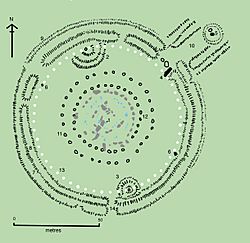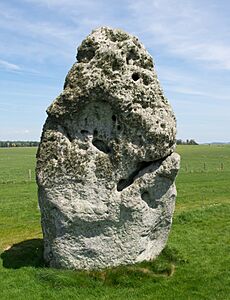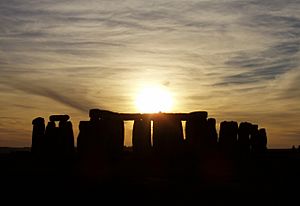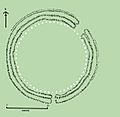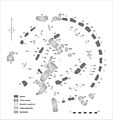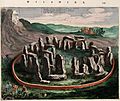Stonehenge facts for kids

Stonehenge is a prehistoric World Heritage Site of megaliths eight miles (13 kilometers) north of Salisbury in Wiltshire, England. It was built between 3100 BC and 1550 BC, and was in use until the Bronze Age. The monument is made of a henge, with standing stones in circles. It is probably the most important prehistoric monument in the whole of Britain, and has attracted visitors from very early times.
Contents
Building Stonehenge
Stonehenge was built in three stages. Most of the construction took place between 2640 and 2480 BC.
The first stage started around 3100 BC. During this stage, people dug a circular ditch and a ring of 56 pits, known as Aubrey Holes.
The second stage started around 2100 BC. During this stage, the Stonehenge builders brought huge pillars of rocks from Southwestern Wales and erected them into concentric circles around the centre of the site. This double circle was never completed, and it was dismantled during the third period of construction.
The final stage probably ended before 1500 BC. During this period, the monument was remodeled. Its builders erected a circle of 30 upright stones, weighing up to 50 tons each, capped by ring of stone lintels. These enclosed a horseshoe-shaped formation of five pairs of upright stones, each pair capped with a stone lintel.
Using DNA analysis, scientists have discovered that the Stonehenge builders originated from modern-day Turkey.
History
Bluestones
The first stone circle was a set of 'bluestones'. These stones are made of dolerite, an igneous rock.
The Stonehenge builders dug holes that held up to 80 standing stones (shown blue on the plan). Only 43 of these can be traced today.
There are several theories about how these bluestones arrived at Stonehenge. The long-distance human transport theory says the Stonehenge builders brought the bluestones from the Preseli Hills in modern-day Pembrokeshire, Wales - 160 miles (260 km) away from Stonehenge. In 2011, a megalithic bluestone quarry was discovered at Craig Rhos-y-felin, near Crymych in Pembrokeshire. This supported the long-distance human transport theory.
Another theory is that the Irish Sea Glacier brought the stones close to Stonehenge. However, there is no evidence of glacial deposition within southern central England. For that reason, this theory has less support than the long-distance human transport theory.
Sarsen stones
Later, around 2400 BC, the Stonehenge builders brought thirty huge grey sarsen stones (sandstone blocks) to the site. They 'dressed' (worked on) the stones and gave them mortice and tenon joints. They erected these stones in a circle 33 metres (108 ft) in diameter, with a ring of 30 lintel stones resting on top. They fitted the lintels together using another woodworking method: the tongue and groove joint. They arranged the remaining bluestones in an inner circle. Each standing stone was about 4.1 metres (13 ft) high by 2.1 metres (6 ft 11 in) wide, and weighed about 25 tons.
The stones may have come from a quarry about 25 miles (40 km) north of Stonehenge on the Marlborough Downs. It is also possible that they were collected from a "litter" of sarsens on the chalk downs, which are closer. The modern Stonehenge consists entirely of original stones (some of which have been replaced in upright position).
Folklore
"Heel Stone", "Friar's Heel", or "Sun-Stone"

The Heel Stone lies northeast of the sarsen circle, beside the end portion of Stonehenge Avenue. It is a rough stone, 16 feet (4.9 m) above ground, leaning inwards towards the stone circle. It has been known by many names in the past, including "Friar's Heel" and "Sun-stone". At the Summer solstice an observer standing within the stone circle, looking northeast through the entrance, would see the Sun rise in the approximate direction of the Heel Stone, and the Sun has often been photographed over it.
A folk tale relates the origin of the Friar's Heel reference.
The Devil bought the stones from a woman in Ireland, wrapped them up, and brought them to Salisbury plain. One of the stones fell into the Avon, the rest were carried to the plain. The Devil then cried out, "No-one will ever find out how these stones came here!" A friar replied, "That's what you think!", whereupon the Devil threw one of the stones at him and struck him on the heel. The stone stuck in the ground and is still there.
Arthurian legend
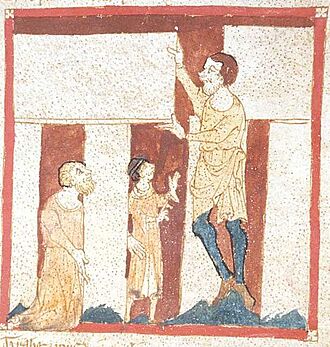
The twelfth-century Historia Regum Britanniae ("History of the Kings of Britain"), by Geoffrey of Monmouth, includes a fanciful story of how Stonehenge was brought from Ireland with the help of the wizard Merlin.
According to the tale, the stones of Stonehenge were healing stones, which giants had brought from Africa to Ireland. They had been raised on Mount Killaraus to form a stone circle, known as the Giant's Ring or Giant's Round. The fifth-century king Aurelius Ambrosius wished to build a great memorial to the British Celtic nobles slain by the Saxons at Salisbury. Merlin advised him to use the Giant's Ring. The king sent Merlin and Uther Pendragon (King Arthur's father) with 15,000 men to bring it from Ireland. They defeated an Irish army led by Gillomanius, but were unable to move the huge stones. With Merlin's help, they transported the stones to Britain and re-erected them as they had stood. Mount Killaraus may refer to the Hill of Uisneach. Although the tale is fiction, archaeologist Mike Parker Pearson suggests it may hold a "grain of truth", as evidence suggests the Stonehenge bluestones were brought from the Waun Mawn stone circle on the Irish Sea coast of Wales.
Another legend tells how the invading Saxon king Hengist invited British Celtic warriors to a feast but treacherously ordered his men to massacre the guests, killing 420 of them. Hengist erected Stonehenge on the site to show his remorse for the deed.
Neighbouring sites
There are also several passage tombs and many tumuli nearby.
Stonehenge, however, does have a number of satellite structures which are part of the 'ritual landscape':
- Bluehenge/Bluestonehenge: a new discovery, one mile to the southeast.
- Durrington Walls: a Neolithic settlement two miles northeast of Stonehenge.
- Normanton Down Barrows: a Neolithic and Bronze Age barrow cemetery.
- Stonehenge Avenue: leads two miles from Stonehenge to Bluehenge on the River Avon.
- Stonehenge Cursus: the largest monument in the area, not easily visible on the ground.
- Woodhenge: found in 1925 by an aerial survey. It had a henge and a wooden circle.
Function
No one knows who built Stonehenge or why they built it. During the summer solstice, the sunrise lines up with some of the stones in a particular way. This suggests that the arrangement of stones may work as a calendar. In Egypt and South America, similar ancient buildings can be found. They also show the time of the solstice.
Some scientists believe that early people were able to foretell eclipses of the sun and the moon based on their positions in relation to the stone monument. The site may have served as an observatory where early rituals or religious ceremonies took place on specific days on the year.
Stonehenge itself is owned by the Crown and managed by English Heritage. The surrounding land is owned by the National Trust.
The World Heritage Site includes Avebury and Stonhenge together, though they are quite distinct.
Setting and access
When Stonehenge was first opened to the public it was possible to walk among and even climb on the stones, but the stones were roped off in 1977 as a result of serious erosion. Visitors are no longer permitted to touch the stones but are able to walk around the monument from a short distance away. English Heritage does, however, permit access during the summer and winter solstice, and the spring and autumn equinox. Additionally, visitors can make special bookings to access the stones throughout the year. Approximately 30,000 local residents are entitled to free admission to Stonehenge under an agreement dating back to 1921.
Related pages
Images for kids
-
Graffiti on the sarsen stones include ancient carvings of a dagger and an axe
-
Sunrise at Stonehenge on the summer solstice, 21 June 2005
-
10th Battalion, CEF marches past the site, winter 1914–15 (WW I); Background: Preservation work on stones, propped up by timbers
See also
 In Spanish: Stonehenge para niños
In Spanish: Stonehenge para niños



